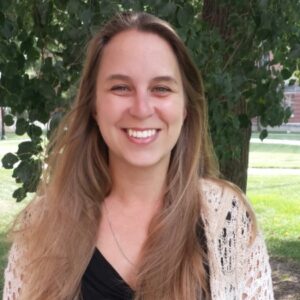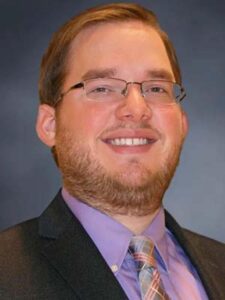Reading Time: 6 minutes
Tell us a little bit about yourself and your background (current title, professional milestones, professional history, education, research works, hobbies, etc.)
Tiffiny D. Rye-McCurdy: I am a lecturer in chemistry and the administrative manager of the Academic Success Center at The Ohio State University at Marion, where I assist students in learning concepts of chemistry and biology both inside and outside the classroom. I currently teach GOB chemistry, general chemistry, organic chemistry and biochemistry. Prior to this position, I taught general chemistry as well as introductory biology courses. I received a B.A. in biochemistry from Ohio Wesleyan University and received my Ph.D. from The Ohio State University Biochemistry program. I am involved in community outreach as the co-coordinator of Ohio State Marion’s science and engineering camps for high school and middle school students. I enjoy visiting local parks with my family and gardening in my free time.
Ryan J. Yoder: I am an associate professor at The Ohio State University, serving the regional campus in Marion, OH. I previously taught GOB chemistry at Marion before joining the full-time faculty in 2013. I currently teach organic chemistry lecture and laboratory courses in addition to serving the campus and university community. I received my B.A. in chemistry from Ohio Wesleyan University and received my Ph.D. from The Ohio State University. I mentor undergraduate research students at Marion and Columbus. I am also currently pursuing chemical education research. I live in central Ohio with my wife and two children where I enjoy family time, travel, cooking, golfing and following sports from around the world.
Tell us about the GOB course at OSU Marion. What are the most rewarding aspects of teaching the class and the biggest challenges?
Tiffiny: The most rewarding aspect of teaching the GOB course is getting to show brand-new college students how basic chemistry relates to their health and physiology. In other general chemistry courses, we never get to emphasize the connection between chemicals and their extensive roles in the human body, and I think that delays student interest in chemistry until much later in their academic careers.
The biggest challenge is that, in covering general chemistry, organic chemistry and biochemistry in one semester, the breadth of knowledge you must communicate is vast. To complicate things, the majority of my class consists of first-year students who may not have developed college-level study habits yet.
How has the GOB course changed over the past few years? How have you adapted your teaching to reflect those changes?
Tiffiny: When I taught this course in 2015, it was a scaled down general chemistry course with an introduction to functional groups and a side of biochemistry at the very end. Now the course gives students a foundation in the core concepts of general chemistry, an extensive dive into not only functional groups, but their physical properties and chemical reactions, as well as an extensive coverage of biomolecules and how they all tie into human nutrition and metabolism. It’s very different from the course it used to be!
Ryan: These developments are influential to the way we wrote the book itself. Since it’s an integrated text, students learn about concepts early on that show up again and again in different contexts in later chapters, which helps reinforce core concepts. For example, the textbook teaches students about molecular shapes, polarity and intermolecular forces in the first third of the book. Then we talk about those intermolecular forces and how they affect the physical properties of organic molecules, learning about them again when we discuss how attractive forces are responsible for the 3-D structures of biomolecules like DNA and proteins. We believe this approach is the most appropriate to balance the tremendous breadth of the course while going into enough depth for faculty to be able to teach students these fundamentals of chemistry properly.
How has your work at OSU Marion influenced your work on “Fundamentals of Chemistry for Today: General, Organic, Biological Chemistry”? What is distinctive about the text? Do you have any suggestions for instructors getting started with the text?
Tiffiny: Despite our differences, Ryan and I are both very methodical in our teaching approaches. We incorporated our teaching pedagogy into this text by presenting a cluster of related concepts, followed by an example problem which is solved step-by-step to show students a logical way to break down more complex problems, and show them the thought process. We follow these in-chapter worked examples immediately with a Learning Check to reinforce what the students learned, allowing them the opportunity to build those critical problem-solving skills.
Ryan: This text not only breaks down complex problems with a step-by-step approach, but the importance of the chemistry is constantly being shown with real-life examples of how it relates to the world around us. Not only is this evident in the way we introduce the concepts themselves, but we also provide extra features throughout each chapter to highlight connections between the chemistry we’re learning and the larger world. We begin each chapter with a Career Focus feature, to show our students that not everyone in health care is a doctor or nurse. And, in fact, many of the topics we cover in each chapter are directly related to a variety of careers in health-related fields. Also, throughout each chapter, we have several Health Connections and Environmental Connections to make the material come even more to life.
How does WebAssign connect to your text? How do you use it in your course? Do you have any suggestions for professors getting started with WebAssign?
Tiffiny: WebAssign for Chemistry, Cengage’s online learning platform, serves as an excellent tool for instructors to create graded assignments using a mixture of end-of-chapter and learning check exercises. I currently use it to assign homework to help students understand the concepts taught during lecture, and next semester I will use it to create extra review assignments (outside the hard-copy review packets I provide now).
Students love the Practice Another feature, which allows them to do a similar problem to those assigned. In fact, sometimes my students do those first to ensure they understand the concept before getting graded on their assignment. They also like the Ask Your Teacher feature, which allows them to ask me a question on specific problems and helps me see where students are struggling to understand when they are on their own. Lastly, WebAssign will soon include videos of Ryan and I working through specific exercises, showing how to approach each problem in a stepwise manner. These will be a great resource that students can watch in addition to the lecture with their own instructor.
How do you see this text deepening students’ engagement with chemistry and fostering more active engagement with core concepts? What is the most significant takeaway students will carry with them after using this textbook?
Tiffiny: I think tying general chemistry to our physiology really helps students connect to the material, when they might otherwise “zone out.” I really think students will have a basic, introductory understanding of chemistry in the body that they can build on when going into a science education or health and medicine field. Examples include conversion in the context of medical dosages, pH in the context of blood buffers, dilutions in the context of medication, REDOX reactions and the role of electron carriers in cellular respiration, how glycolipid antigens determine our blood types, the central dogma and chemicals that serve as micro and macronutrients.
Ryan: I think, in general, students who use this text will see how all of chemistry is connected to itself and how chemistry is connected to their broader world. On that latter point, I believe it’s critical that we included such cutting-edge technologies as COVID vaccines and CRISPR, which are sure to be a part of the health care landscape well into the future. Seeing chemistry in action through such relevant advancements and challenges will allow for more active engagement with the rest of the material. I think the way we scaffold the later organic and biochemistry material also gives students the best opportunity to carry that relevant knowledge further into their academic and professional journey.
 Tiffiny D. Rye-McCurdy is the administrative manager of the Academic Success Center and a lecturer in chemistry at The Ohio State University at Marion. Dr. Rye-McCurdy currently has a rotational schedule teaching GOB chemistry, general chemistry and organic chemistry. Prior to this position, she taught biochemistry and introductory biology and physiology courses. She received her B.A. in ACS-certified biochemistry from Ohio Wesleyan University and her Ph.D. from The Ohio State University Biochemistry program.
Tiffiny D. Rye-McCurdy is the administrative manager of the Academic Success Center and a lecturer in chemistry at The Ohio State University at Marion. Dr. Rye-McCurdy currently has a rotational schedule teaching GOB chemistry, general chemistry and organic chemistry. Prior to this position, she taught biochemistry and introductory biology and physiology courses. She received her B.A. in ACS-certified biochemistry from Ohio Wesleyan University and her Ph.D. from The Ohio State University Biochemistry program.
 Ryan J. Yoder is an associate professor at The Ohio State University, serving the regional campus in Marion, OH. Dr. Yoder previously taught GOB chemistry at Marion before joining the full-time faculty in 2013. He currently teaches organic chemistry lecture and laboratory courses in addition to serving the campus and university community. He received his B.A. in chemistry from Ohio Wesleyan University and his Ph.D. from The Ohio State University. Dr. Yoder mentors undergraduate research students at Marion and Columbus, examining protein-ligand interactions toward therapeutics against threats from chemical weapons and cancer.
Ryan J. Yoder is an associate professor at The Ohio State University, serving the regional campus in Marion, OH. Dr. Yoder previously taught GOB chemistry at Marion before joining the full-time faculty in 2013. He currently teaches organic chemistry lecture and laboratory courses in addition to serving the campus and university community. He received his B.A. in chemistry from Ohio Wesleyan University and his Ph.D. from The Ohio State University. Dr. Yoder mentors undergraduate research students at Marion and Columbus, examining protein-ligand interactions toward therapeutics against threats from chemical weapons and cancer.
Interested in “Fundamentals of Chemistry for Today: General, Organic, and Biochemistry,” 1e by Tiffiny D. Rye-McCurdy and Ryan J. Yoder for your chemistry course? Check out this title now.
The post Q&A With Authors of Chemistry First Edition for GOB Courses appeared first on The Cengage Blog.
Reading Time: 6 minutesTell us a little bit about yourself and your background (current title, professional milestones, professional history, education, research works, hobbies, etc.) Tiffiny D. Rye-McCurdy: I am a lecturer in chemistry and the administrative manager of the Academic Success Center at The Ohio State University at Marion, where I assist students in learning concepts of chemistry […]
Read More…
The post Q&A With Authors of Chemistry First Edition for GOB Courses appeared first on The Cengage Blog. Product Updates, Chemistry, STEM The Cengage Blog






